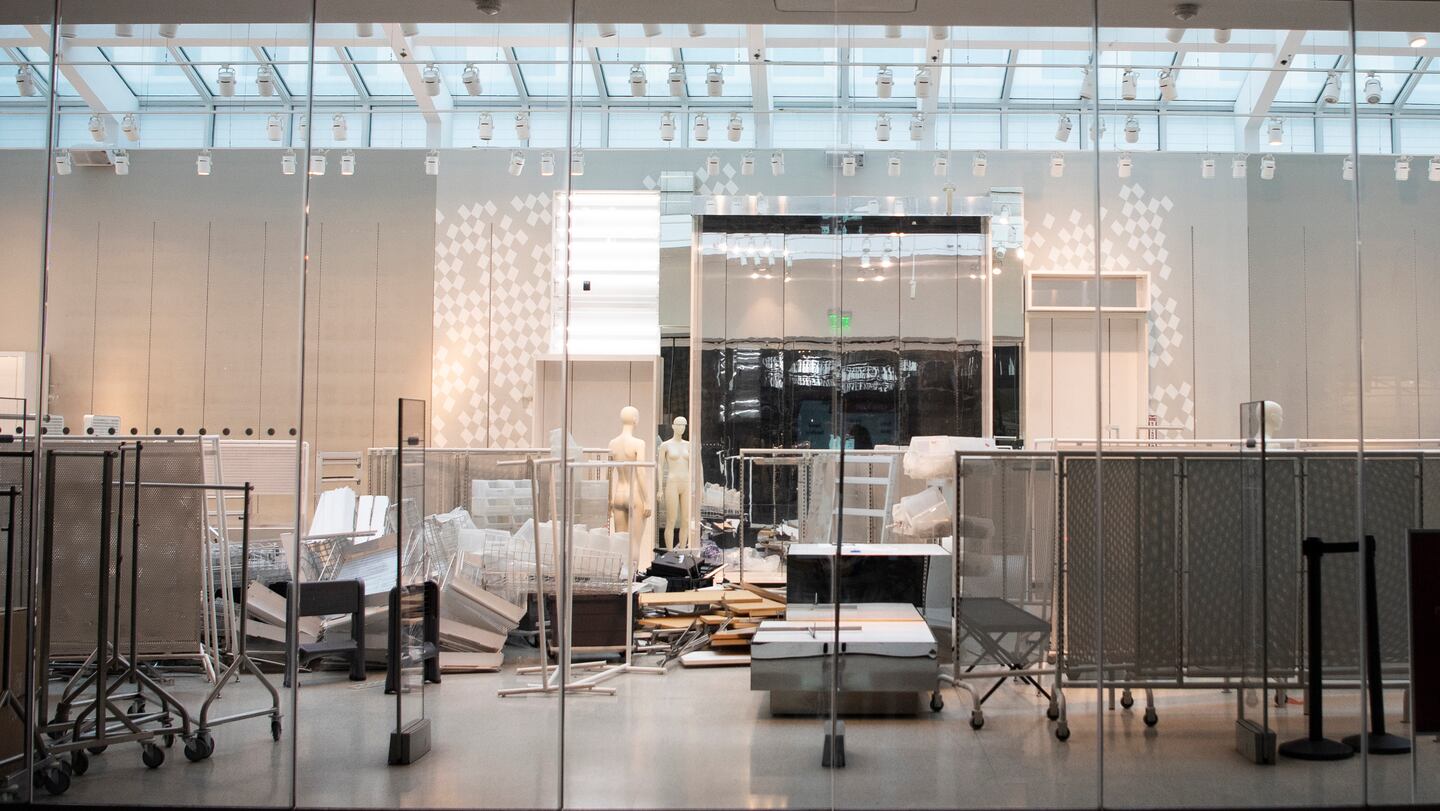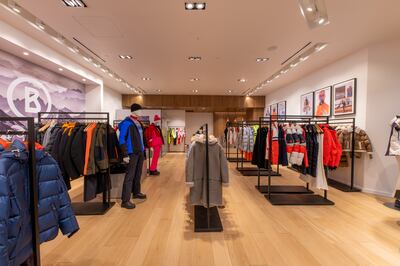
The Business of Fashion
Agenda-setting intelligence, analysis and advice for the global fashion community.

Agenda-setting intelligence, analysis and advice for the global fashion community.

When indoor retail was shut down in California last summer, South Coast Plaza — the nearly three million-square-foot luxury mall in Orange County — had a solution: it would convert its valet parking area into “The Pavilion,” more than a dozen open-air “suites” where customers can make private appointments to try on and purchase items from individual retailers.
Indoor retail has since reopened across the US, but because of its surprising success, the Pavilion will stay indefinitely, according to Debra Gunn Downing, executive director, marketing at South Coast Plaza. Even after regular shopping resumed, customers kept visiting the Pavilion, where order volumes tend to be much higher than average. Since it opened in August, it’s seen more than 5,000 shoppers.
During Covid-19, “brands have had to get really creative,” said Downing. “And then the customer got used to it and the store got accustomed to being able to offer these services,” many of which have become permanent fixtures of the mall, including a curbside pickup offering and a more robust stylist programme.
With the end of the pandemic in sight, retail activity is on track for complete recovery. In the fourth week of March, US apparel traffic grew 7,900 percent year-over-year, according to a recent Cowen report, equivalent to about 62 percent of 2019 levels. Consumers, meanwhile, are already purchasing outfits for their first post-pandemic social event.
ADVERTISEMENT
But brick-and-mortar retail will look differently post-pandemic from how it did in 2019, retail experts say. Many of the consumer behaviour changes adopted in 2020 will likely be permanent and the creative arrangements that retail operators like South Coast Plaza made are turning out to be perennial solutions.
In other words, the pandemic actually forced brands and retailers to have stronger stores with more convenient offerings, from no-contact payment solutions to multiple options combining online shopping with in-person components, such as buy-online, pickup-in-store or buy-online, return-in-store.
When you take a step back, Covid-19 has certainly been an accelerator ... forcing retailers to challenge the retail orthodoxy.
“When you take a step back, Covid-19 has certainly been an accelerator ... forcing retailers to challenge the retail orthodoxy,” said Jean-Emmanuel Biondi, principal and retail expert at Deloitte. His firm is working with multiple retailers to reconfigure their stores to be more relevant in 2021 and beyond.
Below, BoF explores the physical shopping components that will define retail in a post-pandemic world.
1. Frictionless checkout
Many retailers took the downtime last spring as a chance to adopt measures such as no-touch payment in order to minimise physical contact inside their stores.
But even as health concerns ease, consumers will still expect these features. A November survey conducted by Mastercard found that more than half of Americans are now using some form of contactless payment, from Apple Pay to tappable credit cards.
Functions such as self-checkout and mobile wallet are now table stakes for physical retailers, according to Biondi.
ADVERTISEMENT
Activewear brand Fabletics is developing a self-checkout payment option, set for roll out later this year, that allows customers of its monthly subscription to pay on their phones using the brand’s app without having to interact with a sales associate or wait in line, according to Ron Harries, senior vice president, head of retail at Fabletics. The company is also planning to expand a fitting room function that allows customers to find product information or ask for a different size without an associate’s assistance. It’s currently available at 37 of its 50 locations.
2. Seamless transition from online to off
In 2020, curbside pickup or BOPIS, buy-online, pickup-in-store, emerged as one of the fastest-growing ways to shop. A McKinsey report found that adoption of BOPIS grew significantly last year and that 56 percent of consumers say they intend to continue using such methods to shop after the pandemic.
For this reason, South Coast Plaza is also extending its curbside pickup programme indefinitely. The programme allows customers to make product inquiries over the phone, pay with their credit cards and then pick up their orders in a designated location in the mall at their convenience.
More sophisticated BOPIS technologies enable customers to browse store inventory online, such as with Target or Bloomingdale’s — a function that South Coast Plaza retailers haven’t yet adopted. Still, by encouraging customers to reach out directly, the mall and its tenants are building personal relationships between brands and their local customers, an important attribute that’s “become part of the cadence of shopping today,” Downing said.
3. Continued safety precautions
Even as Covid-19 infections fall, keeping the appearance of a clean and well-maintained store and all that entails, will be a “practice that continues,” said Harries of Fabletics, which will also continue to wipe down counters between each contact as the pandemic subsides.
FlagshipRTL, a retail real estate platform that helps brands open pop-up locations, said its clients are all planning to keep hand sanitiser and frequent commercial cleanings as part of their permanent store operations.
ADVERTISEMENT

Some retailers are also factoring social distancing into their new store designs. Jewellery retailer Catbird, for instance, is in the process of renovating its Soho store. Founder Rony Vardi told BoF that the retailer is focused on the store’s floor design, considering formats that feature double display cases to avoid bottlenecks and cash wraps that are spaced far apart so shoppers can be far apart during the checkout process.
4. Hyperlocal strategies
Prior to the pandemic, urban centres benefited from the foot traffic of professional commuters and tourists. Because of remote work, today’s hottest retail locations tend to be “hyper-local,” according to Justin Abrams, FlagshipRTL’s chief executive. That’s why last November, FlagshipRTL opened up a pop-up for skiwear maker Bogner in a mall in suburban Oakbrook, Illinois instead of the obvious choices, the retail-heavy Magnificent Mile in downtown Chicago.
“In the past brands were naturally going to locations with the most cache, and by default, going to Union Square or Rodeo Drive,” Abrams said.
Marketing and merchandising to those specific geographies are also crucial. Abrams points to a menswear brand with one store where the manager had noticed that its children’s products were selling especially well because of its outsized female shopper base. As a result, the brand changed up its product offerings at this location and as a result, saw a 30 percent increase in sales.
5. Smaller stores, bigger back rooms
Neighbourhood-oriented stores can also help retailers save on e-commerce costs. It is significantly cheaper to ship a package from a store located in a customer’s own zip code — if the infrastructure and space to sort, package and send out the online orders exists.
“There’s a history of keeping the backroom as small as possible in order to use the store space, but if you want omnichannel [capabilities], you can no longer rely on the size of the backroom you had before,” said Biondi, adding that a number of his clients are now reassessing their need for greater backroom square footage.
The good news is that retailers no longer need the sales floor to be as big it was 10 years ago, thanks to online shopping. Instead of having to showcase a brand’s entire product collection, a store today serves as more of a touchpoint.
You can no longer rely on the size of the backroom you had before.
Abrams said over 90 percent of his deals with brands are for smaller format stores, somewhere between 800 and 2,000 square feet. (For comparison, the average Victoria’s Secret store is about 6,766 square feet.)
6. Private shopping is here to stay
A number of retailers introduced one-on-one shopping appointments last year, either through Zoom, FaceTime or a private in-person meeting. Now, it’s a method of keeping brick-and-mortar retail relevant, as it’s impossible for consumers to get the same level of service through shopping online, said Jonathan Schley, vice president of global retail advisory at CBRE, a commercial real estate brokerage.
Mikimoto, a jewellery retailer that recently relocated and renovated its flagship store in Manhattan, plans to invest in clienteling services to better connect store associates with shoppers after seeing the success of private shopping during the pandemic, according to Georgina Coleman, vice president of the brand’s retail division.
If you aren’t controlling the shopping experience, there is less and less a need to go somewhere to acquire a product.
“If you aren’t controlling the shopping experience, there is less and less a need to go somewhere to acquire a product,” Schley added.
7. The store as a social hub
The growth of e-commerce has meant that brick-and-mortar stores must provide additional value to their customers, whether that means incorporating on-site services like tailoring and dry cleaning or a cafe.
“Brands need to fit in with the lifestyle of their customers, so that means integrating certain lifestyle [elements],” said Abrams, who pointed to Nordstrom’s Local stores as an example of how retail can incorporate additional services into its offerings.
But the most obvious desire that stores can fulfil is the mass hunger for social programming. After a year of distancing, many people — especially young urbanites — are eager to be around strangers again.
Prior to the pandemic, Catbird hosted regular events at its Brooklyn location, including cat adoptions, meet-and-greets with designers and a book club. Now, Vardi and her co-creative director Leigh Plessner are looking forward to their first post-pandemic event — and they’re thinking big.
“We just want to be in a room together,” said Vardi. “Some that maybe before would’ve been a manicured event with [select] guests, we’re now just talking about opening it up and having a giant pizza party.”
Related Links:
The New Rules of Brick-and-Mortar Retail
Designer brands including Gucci and Anya Hindmarch have been left millions of pounds out of pocket and some customers will not get refunds after the online fashion site collapsed owing more than £210m last month.
Antitrust enforcers said Tapestry’s acquisition of Capri would raise prices on handbags and accessories in the affordable luxury sector, harming consumers.
As a push to maximise sales of its popular Samba model starts to weigh on its desirability, the German sportswear giant is betting on other retro sneaker styles to tap surging demand for the 1980s ‘Terrace’ look. But fashion cycles come and go, cautions Andrea Felsted.
The rental platform saw its stock soar last week after predicting it would hit a key profitability metric this year. A new marketing push and more robust inventory are the key to unlocking elusive growth, CEO Jenn Hyman tells BoF.